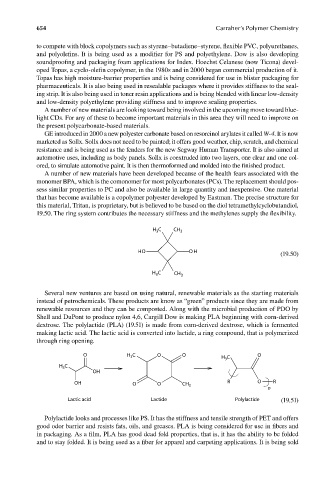Page 691 - Carrahers_Polymer_Chemistry,_Eighth_Edition
P. 691
654 Carraher’s Polymer Chemistry
to compete with block copolymers such as styrene–butadiene–styrene, flexible PVC, polyurethanes,
and polyolefins. It is being used as a modifier for PS and polyethylene. Dow is also developing
soundproofing and packaging foam applications for Index. Hoechst Celanese (now Ticona) devel-
oped Topas, a cyclo-olefin copolymer, in the 1980s and in 2000 began commercial production of it.
Topas has high moisture-barrier properties and is being considered for use in blister packaging for
pharmaceuticals. It is also being used in resealable packages where it provides stiffness to the seal-
ing strip. It is also being used in toner resin applications and is being blended with linear low-density
and low-density polyethylene providing stiffness and to improve sealing properties.
A number of new materials are looking toward being involved in the upcoming move toward blue-
light CDs. For any of these to become important materials in this area they will need to improve on
the present polycarbonate-based materials.
GE introduced in 2000 a new polyester carbonate based on resorcinol arylates it called W-4. It is now
marketed as Sollx. Sollx does not need to be painted; it offers good weather, chip, scratch, and chemical
resistance and is being used as the fenders for the new Segway Human Transporter. It is also aimed at
automotive uses, including as body panels. Sollx is coextruded into two layers, one clear and one col-
ored, to simulate automotive paint. It is then thermoformed and molded into the fi nished product.
A number of new materials have been developed because of the health fears associated with the
monomer BPA, which is the comonomer for most polycarbonates (PCs). The replacement should pos-
sess similar properties to PC and also be available in large quantity and inexpensive. One material
that has become available is a copolymer polyester developed by Eastman. The precise structure for
this material, Tritan, is proprietary, but is believed to be based on the diol tetramethylcyclobutandiol,
19.50. The ring system contributes the necessary stiffness and the methylenes supply the fl exibility.
H C CH 3
3
H O O H
(19.50)
H C CH
3 3
Several new ventures are based on using natural, renewable materials as the starting materials
instead of petrochemicals. These products are know as “green” products since they are made from
renewable resources and they can be composted. Along with the microbial production of PDO by
Shell and DuPont to produce nylon 4,6, Cargill Dow is making PLA beginning with corn-derived
dextrose. The polylactide (PLA) (19.51) is made from corn-derived dextrose, which is fermented
making lactic acid. The lactic acid is converted into lactide, a ring compound, that is polymerized
through ring opening.
O H C O O H C O
3
3
H C
3
OH
OH O O CH 3 R O R
n
Lactic acid Lactide Polylactide (19.51)
Polylactide looks and processes like PS. It has the stiffness and tensile strength of PET and offers
good odor barrier and resists fats, oils, and greases. PLA is being considered for use in fi bers and
in packaging. As a film, PLA has good dead fold properties, that is, it has the ability to be folded
and to stay folded. It is being used as a fiber for apparel and carpeting applications. It is being sold
9/14/2010 3:44:08 PM
K10478.indb 654 9/14/2010 3:44:08 PM
K10478.indb 654

